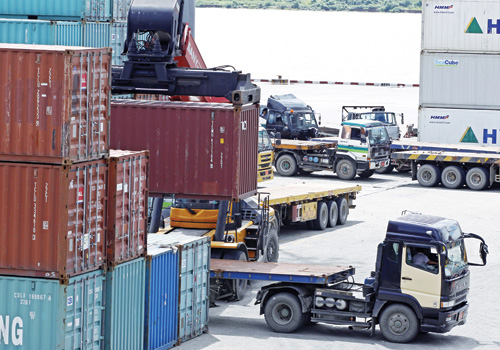No more teething troubles for new customs system
The country’s new automated customs system has no more teething troubles and is up and running at Yangon port, but it is not yet implemented at border points, according to logistics and shipping companies. In addition, the current data entry process remains a significant challenge for the shipping industry.
In January 2017, The Myanmar Times reported that teething problems meant longer rather than shorter waiting times for clearing cargoes. Cross-border traders had not adopted the system yet, due to a lack of internet access and training stops the system for being adopted nation-wide, senior customs officials said.
The new Myanmar Automated Cargo Clearance System (MACCS) went live across Yangon Region on November 12 last year. Despite having a trial period, the system by January had lengthened not shortened customs clearance times.
Ten months since the implementation, businesses said the situation has improved, but cross-border trade are still relying on paper and pens and hence are still suffering from long delays.
Tomoaki Yabe, managing director of Thilawa-based Daizen Myanmar, told The Myanmar Times that teething troubles with the new system have been resolved.
“Despite the confusion during the MACCS implementation period at the end of 2016, within a few months, it was running smoothly.
“We are not facing problems at the moment with MACCS.
“The most remarkable achievement is that MACCS has improved the efficiency and predictability of the customs clearance process,” he said.

Mr Yabe added that the new system has cut down the time needed for the customs clearance process.
“Our past records have shown that what used to take seven to 10 days has been shortened to two to three days.
“This achievement can be attributed mainly to a change from manual filing and submission to a highly systematic submission of documents electronically.
“Operationally, this has benefited us, customs clearance agencies, because it has reduced the number of times we have to visit customs head office and customs at the port,” he continued.
John Hamilton, country manager of CEA Projects Myanmar, said that the situation has improved but border trade remains inefficient because MACCS is not yet adopted at border points.

“[The customs clearance process] seems to be improving but [there are] still long delays on border trade,” he replied in an email to The Myanmar Times.
The authorities would begin implementing MACCS at the border and specifically in both Myawaddy and Muse next year.
Flora Pintusootorn, managing director of Maersk Line Myanmar and member of European Chamber of Commerce Myanmar (EuroCham)logistics advocacy group, stated that from the shipping industry’s point of view, MACCS has significant potential to improve efficiency in the overall process.
“For the past nine months, all involved have been adjusting to the new system and certain processes are starting to improve in terms of speed.
“We observe that on average the overall process is becoming faster when our local Myanmar consignees are doing customs clearance for their import shipments.
“However, the adoption of this system from some parties can still definitely be improved. Sometimes the process hits a roadblock when officers interfere with the processes which would then significantly slow down the customs clearance time,” she said.
Ms Pintusootorn said that the current data entry process is a significant problem, resulting in inefficiency.
“Another significant deterioration to the process is with shipping companies’ manifest submission process to Customs Department [via Shipping Agency Department under the Myanma Port Authority].
“Around the world, big data entries like manifest information has common practice of being sent via Electronic Data Interchange [EDI]. This guarantees speed and accuracy for the data. Before MACCS implementation, shipping companies were already sending import manifest data using EDI to the Shipping Agency Department, then finally passed on to Customs Department.
“When MACCS came in, though the system was designed to be able to accommodate data through EDI directly from shipping companies directly to Customs Department, the rules were still maintained that data must only go through the Shipping Agency Department first.
“Due to the specific format required with the new system, it resulted in shipping companies being burdened with extreme inefficiencies as all manifest data must now be done manually in order to be ready for submission to the Shipping Agency Department – going backwards from even before.
“This not only causes much increased unnecessary work for shipping companies and high risk exposure to incorrect information but it can also result in delays and hefty fines if data is incorrect on the customs clearance process for the local Myanmar consignees as well. This is still a big problem that needs to be addressed,” she noted, adding that the system has shown positive signs but there remains a lot of room for improvement.
“However, we can only achieve further benefits if it is being used in the correct manner, its many functionalities used to its full potential and with as little interference from different parties as possible.
“Of course, flexibility should be an option when information amendment is needed, though keeping the process as lean and simple would be the best way forward for all parties,” the managing director of Maersk Line Myanmar concluded.
Source: http://www.mmtimes.com/index.php/business/27361-no-more-teething-troubles-for-new-customs-system.html


 Thailand
Thailand




